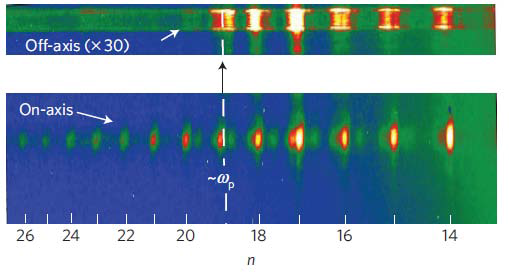As well as creating extreme states of matter, ultra-intense laser-matter interactions have the ability to create bright secondary sources from the UV all the way to the Gamma ray end of the spectrum. The development of such sources opens up new diagnostic techniques, allowing the observation of the fastest dynamic processes on the smallest spatial scales, or the use of advanced imaging techniques such as X-ray phase contrast imaging to produce high contrast images of biological specimens. Work in this field pioneered at the CLF has also opened up new experimental possibilities, combining ultra-intense optical pump beams with a synchronous high brightness X-ray probe beams.
High Harmonic Generation

Figure – Harmonic emission from an intense laser-plasma interaction, taken on-specular-axis.
(Credit – Nature Physics 2009) |
The rapid oscillation of the target front surface as it is irradiated by an ultra-intense laser pulse acts as an oscillating mirror, modulating the reflected laser pulse. The resulting light contains multiple high-order harmonics, often extending to the keV range.
[1] , typically with a brightness that far exceeds conventional gas high harmonic sources.
The coherent nature of these harmonic sources permits pulse lengths down to attoseconds (10
-18s), opening up possibilities to freeze the motion of electrons on the atomic scale.
Next generation Thomson scattering
Relativistic electrons accelerated by an ultra-intense laser can also be used to generate bright MeV photon sources. By utilising the dual beam capability of the Gemini laser a term led by Queen’s University Belfast used one beam to accelerate electrons to 550 MeV, then scattered a second high intensity beam off the propagating electron beam. The ultra-intense interaction led to non-linear multi-photon scattering, generating a gamma ray beam with energies extending out to 18 MeV
[2]. With a source size similar to the accelerated electron beam (30 µm), a low divergence (2.5 mrad) and a short pulse duration (~40 fs) the peak brilliance of (1.8±0.4)×1020 photons s −1 mm −2 mrad −2 far exceeds that produced from existing bremsstrahlung laser sources.
Hard X-ray Bremsstrahlung sources
Ultra-intense laser-matter interactions typically produce highly relativistic beams of electrons, whether the target is a low density gas or a solid. These high peak currents (in the MA range) can generate bright, directional beams of hard x-rays as they transport through a solid target
[3]. Such pulsed sources are well suited to applications relating to radiography or non-destructive testing, with the unique combination of short pulse duration, small source size (<< 1mm2) and high energy comparing favourably to mainly existing commercial systems
[4].
[1] Dromey et al. Nat. Phys. 2, 456–459 (2006)
[2] Sarri et al. Phys. Rev. Lett. 113, 224801 (2014)
[3] Norreys et al. Phys. Plasmas 6 2150 (1999)
[4] Courtois et al. Phys. Plasmas 18 023101 (2011)
Recent CLF Results
Laser-driven x-ray and neutron source development for industrial applications of plasma accelerators (link opens in a new window) - C Brenner et al.
Plasma Phys. Control. Fusion
58 014039 (2015)

(Credit - Brenner et al PPCF 2015)
Using the Vulcan laser, a team of researchers performed proof of principle experiments based around the use of bright laser-driven X-ray and neutron sources. The above X-ray images demonstrate the quality and capability of laser-driven radiography sources.
A laser driven pulsed X-ray backscatter technique for enhanced penetrative imaging (link opens in a new window)R M Deas et al.
Journal of X-ray Science and Technology
23 791-797 (2015)
Ultrahigh Brilliance Multi-MeV gamma-Ray Beams from Nonlinear Relativistic Thomson Scattering (link opens in a new window)G Sarri et al.
Phys. Rev. Lett.113 224801 (2014)
Bright Subcycle Extreme Ultraviolet Bursts from a Single Dense Relativistic Electron Sheet (link opens in a new window)W J Ma et al.
Phys. Rev. Lett.112 235002 (2014)
High order harmonics from relativistic electron spikes (link opens in a new window)AS Pirozhkov et al.
New J. Phys.
16 93003 (2014)
Relativistic electron mirrors from nanoscale foils for coherent frequency upshift to the extreme ultraviolet (link opens in a new window)D Kiefer et al.
Nat. Comms.
4 1763 (2013)
Other Resources
